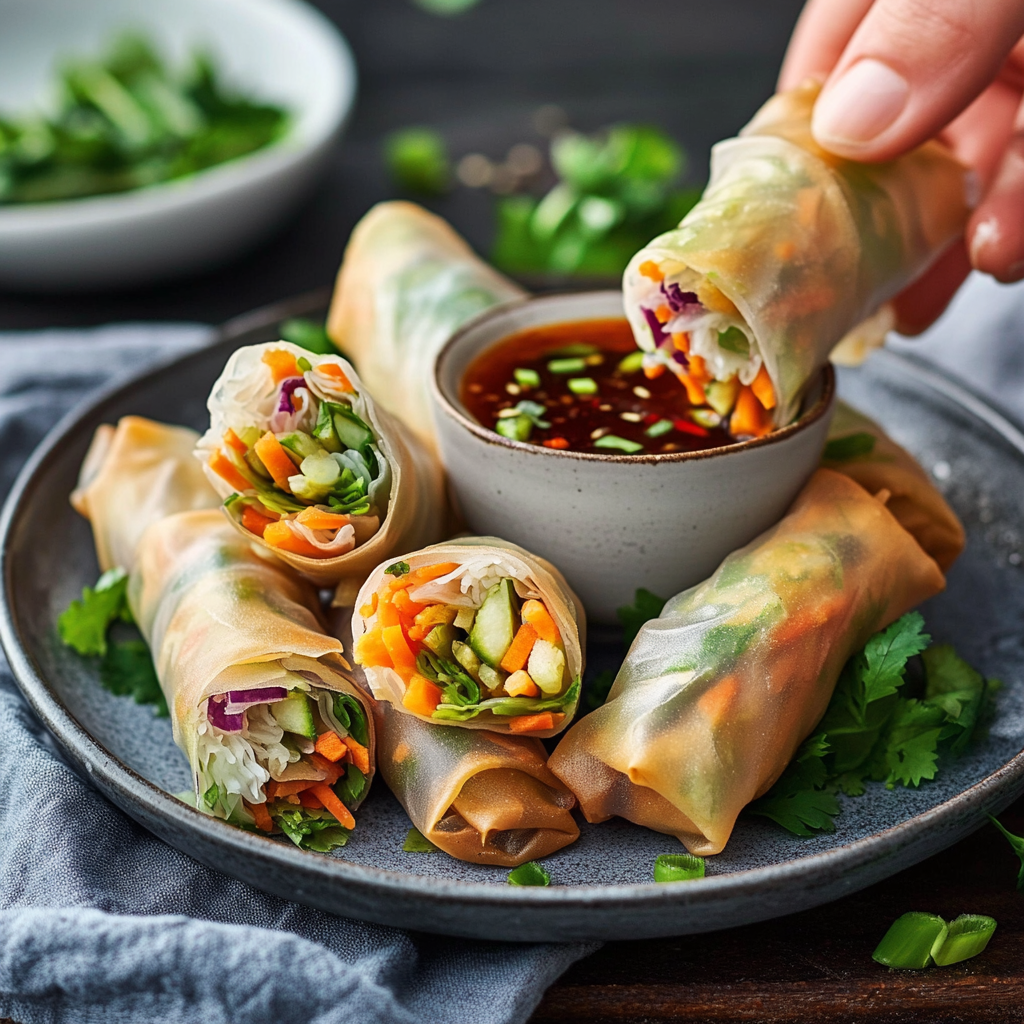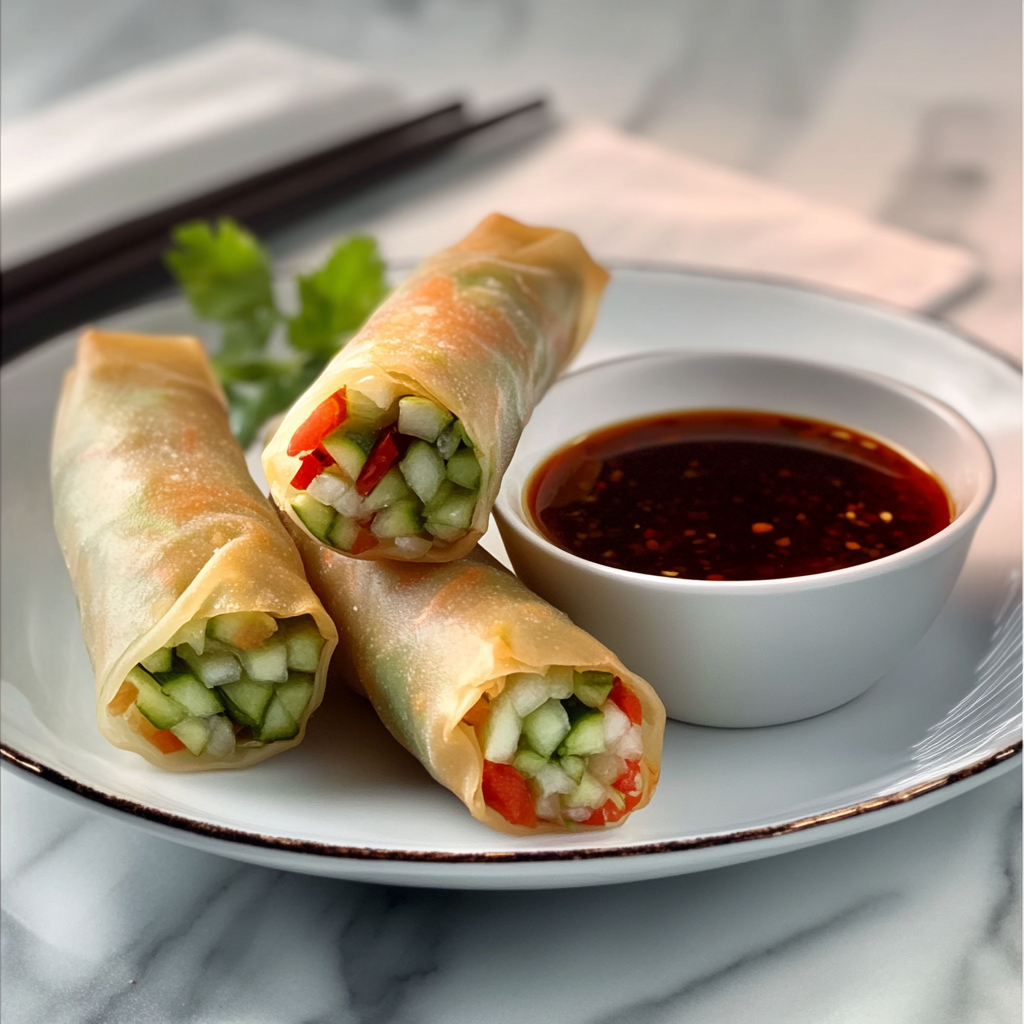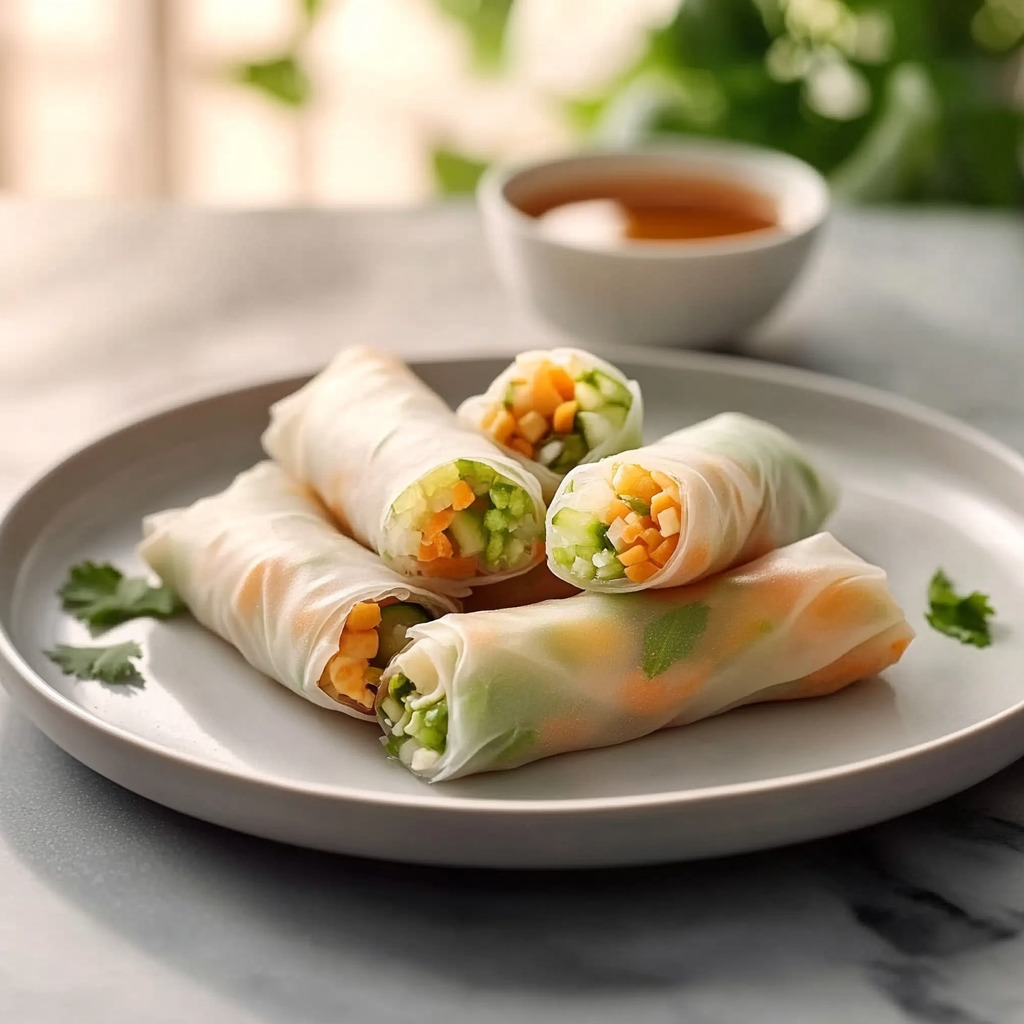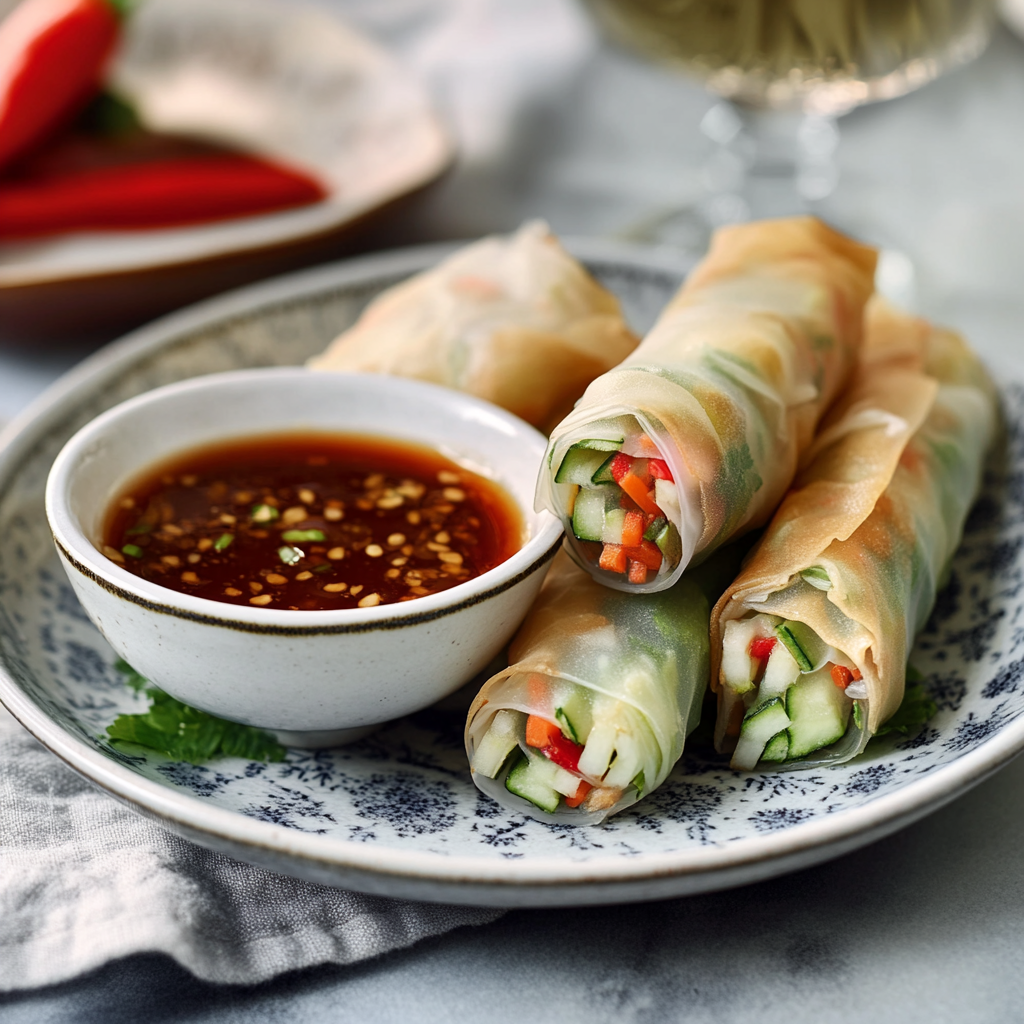Introduction and Quick Summary
Vegetable Spring Rolls with Soy Dipping Sauce are a delightful treat that brings the essence of Asian cuisine right into your kitchen. These crunchy, colorful snacks are not only visually appealing but also packed with fresh vegetables that provide a burst of flavor in every bite. Whether you’re hosting a party, enjoying a family dinner, or looking for a healthy snack option, these spring rolls are an excellent choice. The best part? They are surprisingly easy to make at home!

In this recipe, we’ll guide you through the steps to create your own vegetable spring rolls from scratch. You’ll learn how to prepare the fresh ingredients and assemble the rolls for maximum flavor and crunch. Our accompanying soy dipping sauce adds a savory touch that perfectly complements the lightness of the rolls. With simple ingredients and straightforward instructions, you will impress your friends and family with this delightful dish. Let’s dive into the world of flavors and textures as we explore how to make these delicious vegetable spring rolls!
Main Ingredients
Rice Paper Wrappers
Rice paper wrappers serve as the foundation for our vegetable spring rolls. These thin sheets are made from rice flour and water and become pliable when soaked in warm water. You’ll need about 10-12 wrappers for this recipe, depending on how many rolls you want to make. They offer a neutral taste that allows the fillings to shine while providing a pleasing chewy texture when bitten into.
Fresh Vegetables
Using fresh vegetables is key in creating vibrant vegetable spring rolls. Common choices include shredded carrots, sliced cucumbers, bell peppers, and leafy greens like lettuce or spinach. Aim for about 2 cups total of mixed veggies; this combination provides both crunch and color while delivering essential vitamins and minerals. Feel free to customize based on seasonal produce or personal preferences.
Fresh Herbs
Herbs such as cilantro and mint add an aromatic touch to your spring rolls. Use about ½ cup of each herb for maximum freshness. These herbs not only enhance the flavor but also elevate the overall eating experience, making every bite feel refreshing and bright.
Soy Sauce
For our dipping sauce, you’ll need ¼ cup of soy sauce which acts as the base flavoring agent. It adds saltiness and umami depth to each dip. If you’re looking for a gluten-free option, consider using tamari instead; it offers similar flavor with no gluten.
Sesame Oil
A splash of sesame oil (about 1 tablespoon) enhances the aroma of your dipping sauce while adding richness without overpowering other flavors. This oil is often used in Asian cooking for its nutty taste which beautifully complements the freshness of your vegetable filling.

How to Prepare Vegetable Spring Rolls with Soy Dipping Sauce
Preparing the Ingredients
The first step in making Vegetable Spring Rolls with Soy Dipping Sauce involves preparing all your ingredients meticulously. Start by washing your fresh vegetables thoroughly under running water to remove any dirt or pesticides. Then proceed to slice them into thin strips or shred them where necessary; this ensures they fit snugly inside your rice paper wrappers without bulkiness that could tear them apart.
Next, finely chop your fresh herbs—cilantro and mint—so they can be easily distributed throughout each roll for balanced flavoring. Set aside all prepared components on a clean surface or cutting board; this organization streamlines assembly later on.
Soaking Rice Paper Wrappers
Now it’s time to soak your rice paper wrappers! Fill a shallow dish or plate with warm water—just hot enough that it feels comfortable but not boiling—and gently dip one sheet of rice paper in it for about 15 seconds until pliable but not overly soft (it will continue softening after removal). Lay it flat on a damp kitchen towel or clean surface; this will prevent sticking while rolling.
Repeat this process until you’ve prepared several wrappers at once—aiming somewhere between four to six at first is ideal so you can practice rolling techniques without feeling rushed.
Assembling Your Spring Rolls
With your soaked wrappers ready and fillings prepped nearby, begin assembling each roll carefully yet confidently! Take one wrapper placed flat before you; start by laying down a small handful (about ¼ cup) of mixed vegetables along one edge—don’t overcrowd it! Next sprinkle some chopped herbs overtop before folding over both sides inward toward center like an envelope.
Finally roll up tightly starting from filled edge until completely closed; tucking in ends securely as you go helps keep everything intact during storage or serving! Repeat these steps until all wrappers have been filled then set aside rolled springs onto damp towels ensuring they remain moist until it’s time for tasting!
Making the Soy Dipping Sauce
Your homemade soy dipping sauce is incredibly easy! In a mixing bowl combine ¼ cup soy sauce with one tablespoon sesame oil for added richness then stir together well ensuring even distribution throughout mixture before serving alongside freshly prepared vegetable springs.
If desired consider adding garlic powder (a pinch), chili flakes (for spice), or even honey (for sweetness)—these optional ingredients transform standard sauce into something uniquely yours tailored specifically per taste preference!

Serving and Storing Tips
Serving Suggestions
When serving Vegetable Spring Rolls with Soy Dipping Sauce consider presenting them on an attractive platter garnished with extra herbs around edges as decoration—this creates visual appeal that draws guests’ attention immediately upon arrival at table! You can cut larger servings diagonally into smaller pieces making sharing easier especially during gatherings where multiple people enjoy sampling different foods available.
Additionally pair these delicious snacks alongside other dishes such as fried rice or noodle salads creating an inviting spread suitable for any occasion from casual dinners at home through festive parties celebrating special milestones—all ages appreciate colorful bites served elegantly!
Storing Leftovers
If you’ve made extra vegetable spring rolls (which is likely because they disappear fast!), store any leftovers in an airtight container lined inside with damp paper towels—the moisture prevents wrappers from drying out while keeping fillings crisp longer too! Place container in refrigerator where they’ll stay good up-to three days provided there’s no chance exposure air gets inside causing spoilage prematurely.
For best results consume within first day after preparation if possible maximizing freshness otherwise reheating isn’t advisable post-preparation since texture changes significantly losing desirable crunchiness found originally upon creation!
Enjoy making these scrumptious Vegetable Spring Rolls with Soy Dipping Sauce—you’ll find everyone loves them just as much as you do!
Mistakes to avoid
When making Vegetable Spring Rolls with Soy Dipping Sauce, it’s important to be aware of common mistakes that can affect the taste and texture of your dish. One common mistake is using stale or old rice paper wrappers. Fresh wrappers are essential for achieving the right texture and pliability. Stale wrappers can tear easily and fail to hold the filling together, leading to a messy presentation.
Another mistake is overfilling the spring rolls. While it may be tempting to pack in as many vegetables as possible, overstuffing can result in difficulty rolling and sealing them properly. Aim for a balanced filling that allows for easy wrapping without compromising the roll’s integrity.
Additionally, neglecting to prepare your vegetables properly can lead to a bland flavor profile. Ensure you use fresh, high-quality produce, and consider lightly sautéing certain vegetables to enhance their flavors before adding them to your rolls. This simple step can elevate the overall taste of your Vegetable Spring Rolls significantly.
Lastly, don’t overlook the importance of your dipping sauce. A bland soy sauce can detract from the vibrant flavors of your spring rolls. Experiment with adding garlic, ginger, or sesame oil to your soy sauce for a more complex flavor that complements your rolls perfectly.

Tips and tricks
To create the perfect Vegetable Spring Rolls with Soy Dipping Sauce, there are several tips and tricks you should keep in mind. First, always hydrate your rice paper wrappers in warm water for just a few seconds until they soften but remain firm enough to work with. Over-soaking results in soggy wrappers that are difficult to handle.
Next, consider using a variety of colorful vegetables for visual appeal and nutritional benefits. Carrots, bell peppers, cucumbers, and purple cabbage not only add texture but also provide essential vitamins and minerals. Aim for a combination that balances crunchiness with freshness.
Another helpful tip is to include herbs such as mint or cilantro for added flavor. These herbs enhance the freshness of each bite and create a more aromatic experience when paired with your soy dipping sauce.
When rolling your spring rolls, keep the ingredients tightly packed while leaving room at both ends for sealing. Fold in the sides first before rolling from the bottom up; this helps contain all fillings securely within the wrapper.
Finally, refrigerate your finished spring rolls for about 20 minutes before serving. This allows them to set properly, making them easier to slice if desired. Chilling also enhances their refreshing quality when served alongside a flavorful dipping sauce.
Suggestions for Vegetable Spring Rolls with Soy Dipping Sauce
For an even better experience when preparing Vegetable Spring Rolls with Soy Dipping Sauce, consider incorporating some suggestions into your cooking routine. One effective suggestion is experimenting with different types of dipping sauces beyond traditional soy sauce. Try creating a peanut sauce or a spicy chili dip that pairs beautifully with fresh spring rolls.
Another suggestion involves varying textures in your filling by adding ingredients like avocado or cooked noodles (such as vermicelli) along with raw vegetables. This combination provides creaminess or chewiness that contrasts nicely against crisp veggies.
Additionally, think about meal prepping by making large batches of vegetable spring rolls ahead of time. Store them between layers of parchment paper in an airtight container in the fridge for up to two days; this makes them great snacks or appetizers ready at a moment’s notice.
If you want extra crunch, consider frying half of your spring rolls once they have been rolled instead of serving them raw every time. Frying adds another level of flavor and texture that many enjoy.
Lastly, don’t forget about presentation! Arrange your vegetable spring rolls on a nice platter garnished with sesame seeds or edible flowers; this elevates any gathering and shows appreciation for guests’ dining experience.

FAQs
What vegetables work best for Vegetable Spring Rolls?
When it comes to choosing vegetables for Vegetable Spring Rolls with Soy Dipping Sauce, opt for fresh produce known for their crispness and vibrant colors. Popular choices include carrots, bell peppers (red or yellow), cucumbers, lettuce leaves like butter or romaine, and purple cabbage which adds both color and crunch. You can also incorporate herbs such as mint or cilantro which enhance aroma while providing additional nutrients.
Using seasonal vegetables ensures optimal flavor while maintaining nutritional value; consider local farmers’ markets as resources! Feel free to experiment based on personal preference by trying other options like bean sprouts or avocados too!
How do you store leftover spring rolls?
Storing leftover Vegetable Spring Rolls with Soy Dipping Sauce requires proper handling techniques so they remain fresh longer! The best way is by placing any unused spring rolls inside an airtight container lined with damp paper towels; this keeps moisture intact without turning them soggy!
Make sure not store them too tightly packed together since airflow helps prevent sticking together during refrigeration periods; consume within two days maximum after preparation time! If you want longer-lasting options beyond two days freezing might be necessary—though note that thawed ones may lose some textural quality after being re-frozen later on!
Can I make these spring rolls ahead of time?
Yes! Preparing Vegetable Spring Rolls ahead-of-time is feasible if stored correctly afterward! Complete assembly followed by refrigerating until ready serving works well—just ensure they’re placed into an airtight container layered between damp cloth/paper towels preventing moisture loss while avoiding sogginess—ideal consumption period lasts up-to 24 hours post-preparation though earlier consumption yields fresher results!
Alternatively prepping ingredients beforehand saves significant effort too so that once guests arrive everything’s ready-to-go without additional fuss during gatherings!
Is it possible to make these vegan-friendly?
Absolutely! The beauty behind Vegetable Spring Rolls rests within versatility—by using plant-based ingredients they become an excellent vegan option! Simply omit any animal-derived products such as fish sauce typically found in certain recipes—swapping regular soy sauces out specifically designed versions ensures no hidden animal products are included either!
Be sure check labels carefully purchasing pre-made sauces since additives might vary across brands; homemade versions allow complete control over what goes into meals whilst offering delicious alternatives tailored towards dietary restrictions!
What can I serve alongside these spring rolls?
Serving suggestions accompanying Vegetable Spring Rolls include various complementary items enhancing overall dining experiences! Consider pairing light refreshments like chilled cucumber salad drizzled dressing bringing refreshing notes alongside crispy fried tofu bites packing protein punch!
You could also present rice noodles tossed sesame oil garnished scallions working harmoniously highlighting Asian flavors throughout meal spread while engaging diners fully without overwhelming palates simply enjoying delightful flavors offered within each bite alone showcases culinary excellence effortlessly!
How do I know when my rice paper wrappers are ready?
Identifying perfect hydration level among rice paper wrappers crucially impacts successful wrapping technique during preparation stages necessary achieving ideal outcome! Soak individual sheets briefly (approximately five seconds) within warm water until soft yet pliable enough enabling smooth manipulation without tearing apart—test flexibility gently lifting edges ensuring no stickiness remains upon touching surface prior proceeding further assembling fillings down center area equally spaced out allowing adequate room folding over edges neatly securing contents inside firmly yet delicately maintaining aesthetics visually appealing completed product served later on table setting occasions alike!
Conclusion
In summary, creating delightful Vegetable Spring Rolls with Soy Dipping Sauce involves avoiding common mistakes and following helpful tips for successful preparation. Selecting quality ingredients, using proper storage techniques, and embracing creativity all contribute to a fresh and flavorful outcome. These carefully crafted rolls become the centerpiece of gatherings, uniting people through food, while nourishing both body and soul. The joy of shared meals fosters lasting memories, celebrating love and connection around the table. Beyond the meal itself, this culinary experience encourages healthier lifestyles and strengthens bonds among family and friends. Through cooking, we explore diverse cuisines and unlock the hidden treasures of flavors, inspiring creativity and passion in the kitchen. Every recipe becomes a journey of discovery, enriching wellness and cultivating unity across communities. The joy of cooking and sharing food transcends time, leaving a lasting impact on future generations.




